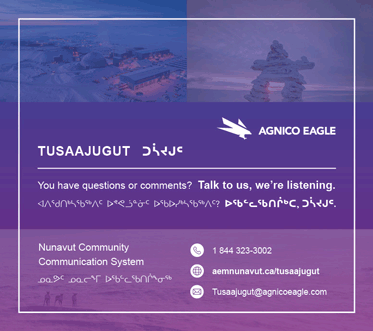Community reps: Will Mary River damage small mammals?
“We did not consider things like small mammals”
Community representatives from Igloolik, Pond Inlet, and Kimmirut told the Nunavut Impact Review Board July 19 that the final environment impact statement for the Mary River iron-ore mining project contains a big gap: no assessment of the project’s impact on small mammals.
Small mammals such as Arctic hares and lemmings are not dealt with in the FEIS, which was put together by Baffinland Iron Mines Corp.
“No, we did not assess specifically the effects on small mammals,” said Baffinland’s terrestrial technical consultant, Mike Setterington.
“We considered wolves as a qualitative assessment, but we did not consider things like small mammals like the Arctic hares,” Setterington said.
Fifty community representatives from 11 communities appeared at the Nunavut Impact Review Board’s final hearings on the Mary River project.
They asked questions July 19 and 20 during community roundtable sessions.
The Steensby Port, from which iron-ore will be shipped to market on 12 large ore carrying vessels, would be located 150 km northeast of Igloolik, connected by rail to the mine site 160 km south of Pond Inlet.
The loss of small mammals is a “major concern” to Igloolik, one representative said, saying wildlife feed off the tundra as caribou migrate through the land.
“When you do an impact assessment, you have to focus on what are called the value components, as opposed to trying to assess everything out there. And focus on some of the key species. And caribou is the key species we focused on,” Setterington said.
A “zone of influence” was assessed for all terrestrial wildlife habitats, Setterington said, where explosions may disturb mammal habitats for up to 14 km around the mine site and the railway.
This poses a problem, because caribou and Inuit hunt for small mammals, and this may compromise the caribou population, said chairperson of the Pond Inlet Mary River project committee, Jesse Nutarak.
He was flown down to the hearings this week by the Qikiqtani Inuit Association to voice his opinions.
He said caribou need these small mammals to eat.
“We know they are part of the ecosystem to balance the whole environment. They should be considered to be impacted,” Nutarak said.
“It all sort-of domino effect. From very small plankton to the carnivores, yes this will have an impact,” he said.
Itee Temela of Kimmirut also said her community is worried about small mammals because of the dust the project would emit.
“There will be dust produced from this project, but it will be very localized to the footprint of the project,” Setterington said, but he did admit that mammal habitats would be effected.
“No doubt there is going to be some habitat lost for small mammals, and we did assess that in the FEIS,” Setterington said.
“As far as the dust effecting small mammals across a broader area, there won’t be an effect on dust on small mammals, beyond a very small area surrounding the mine area itself and along the road,” he said.
Baffinland did see an abundance of snowy owls and lemmings in its latest bulk sample of the area, but maintains there will be no significant impact on smaller mammals.
“Even though we didn’t do an assessment on small mammals itself, just looking at impacts from other northern mining projects and even southern mining projects, the effects on small mammals are limited,” Setterington said.





(0) Comments